
|
||||||||||||||||||
|
|
||||||||||||||||||
|
| ||||||||||||||||||
  






  









| ||||||||||||||||||
Evolution of Bigfoot's Face
by Matt Moneymaker 09/12/2024
This article was prompted by an important bigfoot sighting in June of 2024. Two witnesses got a very close look at a bigfoot (less than 15 feet away) at night but lit up by powerful fog lights on their 4x4 truck. For details, maps, etc., see report 77610, Logan County, New Mexico.
The witnesses, Irwing Aguilera
and his son, drove right next to a bigfoot, rolling by very slowly on a remote jeep
trail in the Gila Mountains. They both observed the bigfoot for about 10 seconds
as they passed it. It was holding perfectly still,
apparently pretending to be big stump. It was on the right side of the road in
the dark in drizzling rain. Irwing says it was close enough that his son could
have poked it with a broom stick.
The Aguilera's close range
observation of the bigfoot's face under very bright lights makes them both very
qualified to judge various depictions of a bigfoot's face, and say which ones
are more accurate and which are less accurate.
The depictions of a bigfoot's face that matter most, for the purposes of this discussion, are those which are most influential in the popular imagination. Those most influential depictions have come in two forms: statues and costumes.
The Aguilera's said that it did not look like what they had previously envisioned a bigfoot's face would look like. They were both familiar with popular depictions such as Harry Henderson, Jack's Link Sasquatch, and the popular Garden Yeti statues.
The Aguileras had never seen a photograph of Jim
McClarin's O'Mah (Bigfoot) statue in Willow Creek California (see below) before
I sent it to them. The Aguileras say that statue looks much closer to what they
saw than mdoern commercial depictions.
McClarin's O'Mah was the very
first attempt to carve a lifelike and life-size statue of a bigfoot based on
eyewitness descriptions. Those particular eyewtiness descriptions that contributed to
McClarin's O'Mah statue were from northern California. Whereas, the Aguilera's bigfoot was
encountered in the Gila Mountains of New Mexico.
It is very likely that all bigfoots in
North America have the same general face structure and body shape ...with
variable factors such size, age, and nutrition level ... just as all American
black bears have more or less the same face structure and body shape, with
variables for size, and age, and nutrition level. So the bigfoots in
California will look very similar to bigfoots in New Mexico, Ohio, Florida,
Massaschusetts, etc.
The fact that HUMANS might have more diverse
appearances in the face is a consequence of our much larger population count and
global range. Whereas, a nomadic population in North America that is barely
sufficient enough, collectively, to maintain genetic viability, will naturally
be much less diverse in appearance.
Although bigfoots can be found in
isolated pockets, they do not remain in those pockets their entire lives. Their
DNA mixes across the continent over time.
FUR COLOR of a bigfoot is a different story, in terms of diversity, because the
color and texture of fur is affected so much by the environment, including
things like the degree of sunlight
exposure. The fur color might be more diverse than facial appearance purely by environmental factors, but
there may be a genetic component as well, as there seem to be among black bears.
Some black bears are jet black, some are cinamon color, some are almost
blond. However,
the face shape of all these black bears is more or less the same. Bears also
range out from isolated pockets. Their DNA mixes from habitat pockets in
American states up and down the East Coast, among other places.
The
COMMERCIAL DEPICTIONS of bigfoot faces are pretty far off the mark from the real
thing. It is helpful to know the history behind the most influential commercial
depictions. It is instructive to understand why the commerical depictions
"evolved" the way they did. This article will allow you to show people snaphots
of this evolution over the decades.
I cordially invite anyone and everyone to plagiarize me if they need to.
Attribtuion is unnecessary because most of this stuff is "out there" and
somewhat obvious. You can make your own show-and-tell about this particular
topic, perhaps for a school paper, or a page on a web site, or a talk at a
bigfoot conference. It can be re-purposed into a very visual and relatable
slideshow talk.
If you make your own slideshow with these images and
some insightful, well-timed color-commentary .... you will surely get wows
and lots of laughs from the audience, especially among foks of a certain age.
Your bigfoot talk will not be over anyone's head, so to speak.
The depictions below were not the
only commercial depictions. They are the commerical depictions from the 1970's
and onwards that were seen and recalled by the most people. They have been the
most influential in forming public expectations about the appearance of bigfoots
|
1976 - Six Million Dollar Man The Bigfoot costume was worn first by big man wrestler "Andre the Giant" (7 feet 4 inches tall) and then later by Ted Cassidy (6 feet 9 inches tall). Cassidy was more famous for playing the butler "Lurch" in the original "The Addams Family" TV series of the 1960's. |
||
 |
|
|
In this first, widely remembered bigfoot costume, you see some of the fiunctionality needs of the role. The human face projects the crucial interactive expressions, and aggression, and ferocity that people understand, so the face cannot be covered with a mask that does not allow that expression to come through on camera. The actors wore skin darkenning makeup. Their otherwise bare faces were garnished with an untamed bushy beard, moustache and wig. Instead of creating a costume to make the actor's head appear larger, the producer cast actors who had the biggest faces on the tallest bodies. In this era, the two most experienced actors in Hollywood with those criteria were Andre the Giant and Ted Cassidy. Andre played bigfoot in the first bigfoot episode on the Six Million Dollar Man series. Cassidy played the bigfoot in subsequent episodes of the series ... and he was probably glad to get the work. These were popular shows, and they introduced the Bigfoot character concept to mass audiences, setting the stage for further exploration of this character type. Ten years later a whole new Bigfoot angle would emerge. |
||
| 1987 - Harry and the
Hendersons The costume for Harry and the Hendersons was worn by former professional basketball player Kevin Peter Hall in 1987. Kevin Peter Hall was 7 feet 2 inches tall and slender. He was so good at enduring the discomfort of a full body costume for hours at a time that he was cast to play another uncomfortable monster role that same year, pitted against Arnold Schwarzenegger in the hit film "Predator". |
||
 |
||
| Hall was the right body type for the next level of
costume a decade after the 6 Million Dollar Man. His tall slender body
allowed for a padded costume that would appear as huge muscles without
distorting the body appearance too much. The costume for Harry had different functional needs than the bigfoot in the 6 Million Dollar Man. Harry was not just a scary monster. He was a loveable ape-man. He needed to express a wider range of emtions, not just growly looks. But he also had to be a bigfoot. Bigfoot is big all over, including its head. |
||
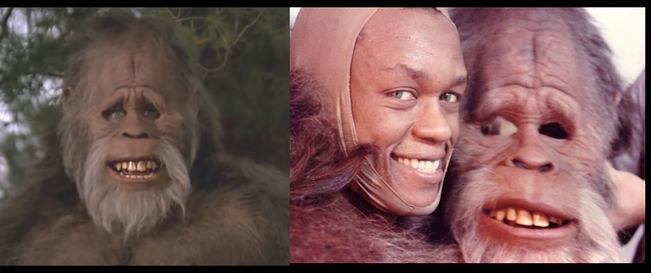 |
||
The "animatronics" were driven by wireless mini-servo motor technology that controlled Harry's facial expressions (technology not available in 1976). Animatronics allowed costume designer Rick Baker to make Harry's head larger than a human head without it being too noticeable that the eyes are too close together for a face that size. The narrow eyes on a big fake head looked awkward ... but they don't look as fake as they would look if they were big remote controlled eyes. Real eyes "gave him a soul." This is where the creative needs for a commerical depiction set the foundation for the "classic" bigfoot/sasquatch look that has endured. Now that you are more aware of the narrow space between the eyes on the Harry costume, it should be obvious that the overall head shape of Harry was the result of a need create a large head around a human face. The forehead size is also exaggerated to make the head appear larger. That unnaturally distorted head shape stuck, for decades. In the screen cap below you can see the design challenge. The designers needed to make Harry's head much bigger than an adult human head so it would seem sufficiently monsterous. Actor John Lithgow is a tall actor also. He stands 6 foot 4 inches tall. His head was roughly the same size as the head of actor Kevin Peter Hall, but Lithgow's head seems to be half the size of Hall's head when Hall wore the big mask. |
||
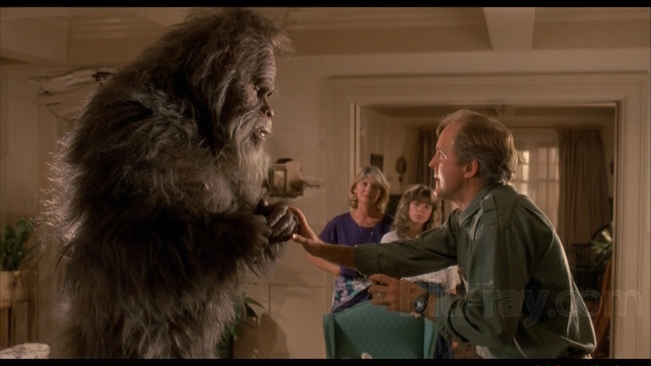 |
||
This need for real-ish facial expression is reason for this distorted head shape of Harry Henderson. That distortion influenced the most widely seen depictions of bigfoots/sasquatches/yetis for the next 35 years. 1990's - Sky Mall "Garden Yeti" Beginning in the mid 1990's, and for roughly the next ten years, a catalog named "Sky Mall" magazine could be found in the back seat pockets of 88% of airline seats in the sky. Nearly everyone flying on an airline in the 1990's leafed through this catalog while travelling, amused by some of the product offerings. Some of Sky Mall's most famous items were the "Garden Yeti" statues. The six foot tall version costs nearly $3,000. The smaller version cost roughly $300 with shipping. Many people bought these statues for their homes and gardens, so many people saw them. They became very influential on the public's perception of the appearance of bigfoots/sasquatch/yeti. |
||
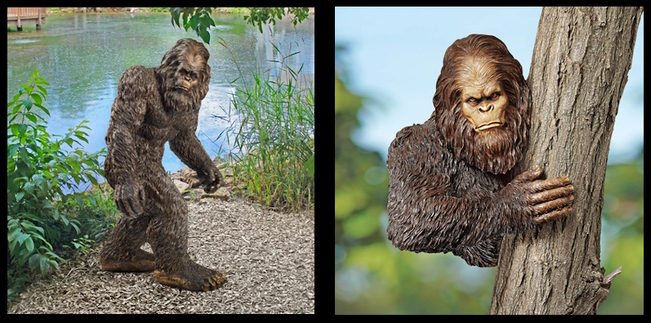 |
||
| Garden
Yetis are clearly based on the distorted head shape of Harry Henderson.
The sculptor for Design Toscano was not trying to create anatomically
correct yeti. He just wanted something recognizably bigfoot-ish ... so
he modelled his creation on the most widely know progenitor -- Harry
Henderson from 1987. |
||
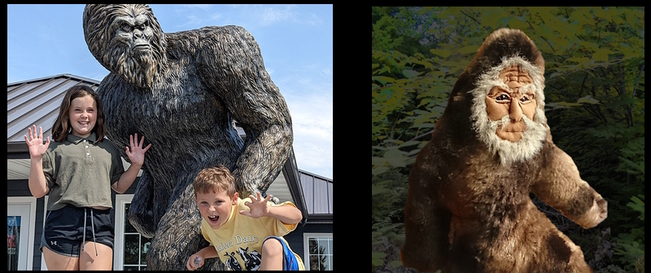 |
||
The large distorted Harry Henderson head shape carried over to the Garden Yeti statues and to most other statues and dolls created after that. In all of these depictions you can see the influence of the first distorted head of the Harry costume. The head distortion was originally driven by a need to create an enlarged sympathetic face rather than just a scary face, but subsequent depictions that needed to be scarier bigfoots than Harry ... continued to include this same distorted Harry head shape. None of these commercial depictions are based on eyewitness descriptions. The designers considered sasquatches to be only mythical creatures, so their appearance only had to be consistent with the most widely seen prior depictions of mythical creatures. 2006 - Jacks Links Sasquatch By 2006, when the Jack's Links (Beef Jerky) "Messing with Sasquatch" advertising campaign launched, the Harry Henderson distorted head shape had became firmly rooted in the popular imagination. |
||
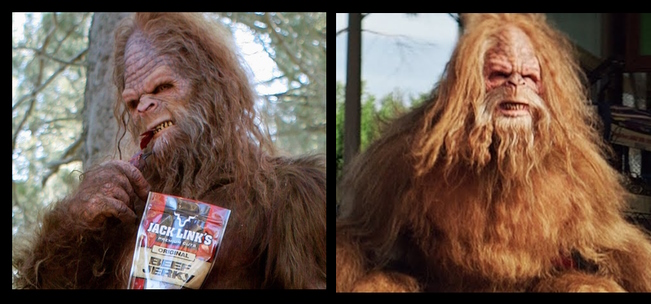 |
|
|
The Jack's Links sasquatch is not loveable. It has only two modes of being: scary and scarier. It doesn't need the range of expression that Harry Henderson has, nor does it need to be so much larger than most human actors. As a result the mouth muzzle is smaller than with Harry, but the tall bare forehead is the same. It is an unnaturally high forehead, peaked like Harry, for no other reason than to fit the popular pattern that had been established by the Harry costume 20 years prior. That is what bigfoots are "supposed to look like" ... if you are only considering versions made for purely commercial purposes, rather than representing what witnesses actually describe. At no time did it occur to any of the costume designers that this strange head shape is not well adapted to environmental exposure all of the time, not unless it would be wearing a hat all of the time. Sasquatches do not wear hats. This sasquatch would need to wear a hat of some sort, or it would soon die from hypothermia in the environments where it lives. On real sasquatches the forehead is not visible AT ALL under its hoodie-like locks. The head of a real sasquatch is completely covered by hair, leaving the face in a bit of a shadow. It is very possible that sasquatches have a shorter coat of hair in summer, and then grow a longer coat in winter, just like many other large animals adapted to seasonal extremes. A large portion of eyewitnesses mention that the fur on the bigfoot they saw was shaggier and longer, especially around the head, than what you see in Patterson footage. The Patterson Creature ("Patty") was filmed in October when it was still warm in those mountains. As emphasized above, some diversity in fur description is to be expected. It does not mean that bigfoots with different fur lengths, fur densities, and/or fur colors are different sub-species. The same applies to black bears (Ursus Americanus) and humans. Many different hair colors and hair lengths and hair densities among the same species. 2024 - Sasquatch Sunset In 2024, a feature film was released in theaters titled "Sasquatch Sunset". Some big name stars protrayed a family of sasquatches in their uncomfortable, unforgiving natural environment. |
||
 |
||
In this film the pendulum swung back to more sympathetic, loveable sasquatches. There had to be facial expression that could be affected under latex prothetic pieces ... but not the big adorable facial expressions achieved with the 1987 motorized Harry costume. Nor did they need to be extra large actors in those costumes in order to contrast with human characters standing nearby them. There are no human characters in the film to tower over. With no need for giant proportions there was no need for little servo motors to control facial expressions. The faces could differ a bit to make each sasquatch distinctive. Although the producers wanted dirty realism in their sasquatch costumes, the only references they had for a sasquatch face were the popular progenitors of the Garden Yeti, Jacks Links sasquatch, and the Harry Henderson costume. Once again, creative needs were more important than anatomical accuracy. The sasquatches in this film needed to look like to what the audience expect a sasquatch would look like. That expectation had already been established in prior costumes and statues. The producers did not want to stray very far from a "classic sasquatch" look. Afterall, part of the draw of the film was to see the lives characters they had only had only been teased with in prior incarnations. |
||
The First Attempt at Anatomical Correctness (Aguileras say this is much closer to the real thing) 1967 - O'Mah (Bigfoot) Statue, Willow Creek, CA Around the same time frame that the Patterson footage was obtained in 1967, a college student in Northern California named Jim McClarin was tasked with carving a lifelike and life-size depiction of a bigfoot as part of a community development project for the town of Willow Creek. Willow Creek is a little mountain town situated at an important crossroads the northwest corner in California. This is the town where Patterson returned to after he and Bob Gimlin obtained their famous film on Bluff Creek. |
||
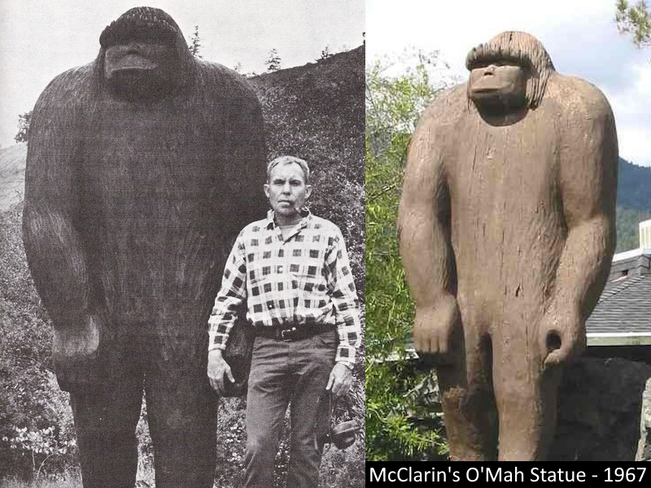 |
|
|
| There were no dominant commercial depictions of bigfoot at that
time, no popular films or other statues from which McClarin could draw
inspiration. His inspiration came only from witness descriptions.
Consquently he carved a depiction that was closer to being anatomically
correct than any of the popular commercial depictions after that point.
Making a costume based of the 1967 O'Mah statue would have been problematic because the facial expressions would not be humalike enough to be recognizable to the average moviegoer. The eyes would have to be spaced apart anatomically correctly, which puts them out of range for a costumed actor to portray, even Andre the Giant. You can't put a human face convincingly into a life-size O'Mah mask because human heads are so much smaller. If you ever see a real sasquatch up close under good lighting conditions, you will see something that looks more like this statue than any of the more popular commerical depictions of these same creatures. I asked the Aguileras to look closely at photographs of the O'Mah statue and say how they would change the statue to make it look more like what they observed. They said the face would need to be flatter and the nose more prominent. Irwing noticed a sharp bridge on the nose, like a human, but widening out in a more triangular pattern. Rather than having a tall exposed wrinkly forehead, this creatures forehead was not visible at all because its wet matted locks formed someting like a hoody around its face. All of these elements are very consistent with what you would expect from surviving megafauna adpated to Ice Age conditions. |